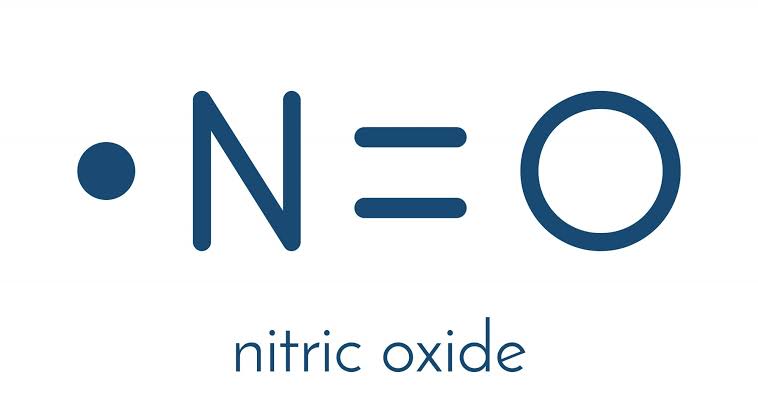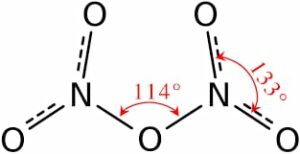In this article, we will understand N 5 double bond examples with various examples by studying their preparation and properties.
To understand the double bond examples, it’s crucial first to know what does a double bond mean or what do you understand by a double bond? When sharing of two pairs of electrons takes place between atoms, it leads to the formation of the double bond, which is also covalent in nature. When nitrogen is connected to carbon by forming a double bond, it is called an imine.
1. Nitric Oxide (NO)
JB Van Helmont was the first to discover this gas in early 1600. Mayow prepared it in the year 1669 by the action of nitric acid on iron, but Priestley (1772) is regarded as the real discoverer of nitric oxide as a new compound.

Image credit : Diabetes self management
Preparation of NO:
- On the action of dilute nitric acid on copper(laboratory method)

Copper chips are placed in a Woulfe’s bottle, and some water is added and some water is added Nitric acid (concentrated in nature) is poured (through the thistle) and liberated (nitric oxide) is collected (over the water).
The gas is purified by absorbing it in ferrous sulfate solution and heating the dark brown nitroso ferrous sulfate obtained when pure nitric oxide is liberated.

- A pure sample of the gas is obtained by the deduction potassium nitrate by heating with ferrous sulfate acidified with sulphuric acid ( laboratory method)

In the above reaction, ferrous chloride acidified with hydrochloric acid can also be used in place of acidified ferrous sulfate.
Or, nitric oxide can be obtained when acidified (ferrous sulfate) solution is warmed with a concentrated solution of sodium nitrite.

- Alternatively, by oxidation of N2 of the air by passing air through an electric arc when nitrogen and oxygen of the air directly combine to give nitric oxide. (this is a commercial method)

- Also, catalytic oxidation of ammonia by passing a mixture of ammonia(1vol) and air (8 vol ) (over heated platinum gauze) at 1070 K ( this is a commercial method)

Preparation of Nitric Oxide.
- It is considered to be a colorless gas ( which is a little heavier than air). It can be liquefied at 123.3 K. In liquid state- blue color (boiling point is 123K). At 112 K, it freezes to a blue solid.
- When it comes in contact with air, it immediately gives reddish-brown nitrogen dioxide fumes. It is not possible to describe its smell or physiological action.
- Soluble in water (sparingly).
- It is liquefied with great difficulty under high pressure and low temperature. Liquid nitric oxide( boiling point123 K ) is colorless in the absence of air and solidifies to a white solid ( melting point 112 K ).

- Supporter of Combustion: It is combustible and supports the combustion of only boiling sulfur and vigorously burning phosphorus. Burning sulfur and feebly burning phosphorus are extinguished. Red hot iron wire burns in nitric oxide.

Red hot copper decomposes the gas to form nitrogen and copper oxide.

- Oxidizing Properties: When the nitric oxide ( Nitrogen(II) oxide ) acts as an oxidizing agent, it usually reduces to nitrogen, but occasionally ammonia or nitrous oxide ( Nitrogen(I)) is also formed. It thus oxidizes hydrogen to water, sulfurous acid to sulphuric acid, and hydrogen sulfide to sulfur.

- Reducing Behaviour: It combines (directly )with oxygen to give( reddish brown in nature ) fumes of nitrogen dioxide. With chlorine, it gives nitrosyl chloride ( NOCl).

Due to its easy oxidation property, it acts as an excellent reducing agent. It reduces (acidified ) potassium permanganate and is itself oxidized( to nitric acid). It is also oxidized to nitric acid by iodine( dilute solution).
Concentrated nitric acid oxidized nitric oxide to nitrogen dioxide according to the following reversible equation:

The above equation explains as to why concentrated nitric acid reacts with metals to give nitrogen dioxide while dilute nitric acid yields nitric oxide. With concentrated nitric acid, the reaction proceeds in the forward direction, but in the presence of water, e.g., with dilute acid, it proceeds backward. With (moderately) strong nitric acid,( both) the gases are evolved.
Read more about : SN2 mechanism
Uses
- In the preparation of nitric acid.
- In the detection of oxygen to distinguish it from nitrous oxide.
Structure
Nitric oxide molecule possesses a total of 11 electrons in the valence shells of nitrogen and oxygen atoms. The paramagnetism behavior tells us about the presence of an odd number of electrons, but their properties are different from other odd electron molecules in the following ways :
- Regarded colorless ( in a gaseous state) turns brown when exposed to air and is blue in the liquid state.
- It is comparatively less active chemically.
- It does not dimerize under ordinary conditions.
2.Nitrogen Dioxide
Preparation
- In the reaction of nitric oxide with oxygen, it results in nitrogen dioxide.

- Laboratory method: It can be conveniently prepared in the laboratory by heating lead nitrate in a hard glass test tube.

Nitrogen dioxide is condensed to liquid nitrogen tetraoxide in the U-tube dipped in the freezing mixture.

Properties of Nitrogen Dioxide
- Physical
- It is a reddish-brown gas with a pungent smell.
- It associates or decomposes with a temperature change.

This shows that with a fall in temperature, nitrogen dioxide molecules associate to give dinitrogen tetroxide ( N2O4).
- It is soluble in water, with which it further acts chemically. It dissolves in nitric acid, giving fuming nitric acid.
- It is highly poisonous and corrodes the skin. When inhaled, it produces headaches and sickness.
Read more about : SN1 mechanism
- Chemical
- Acidic Behaviour: Nitrogen dioxide (mixed anhydride of nitrous and nitric acids), oxyacids containing nitrogen( in the +3 and +5 oxidation states), respectively. It is acidic towards litmus and neutralizes alkalis to form nitrates and nitrites.

- Supporter of combustion: It is combustible but supports combustion of brightly burning phosphorus, magnesium ribbon, or glowing charcoal. Burning sulfur or candle is, however, extinguished.
- With Sulphuric Acid: Concentrated sulphuric acid absorbs nitrogen dioxide forming nitrosyl hydrogen sulfate.

Uses
- In the manufacture of nitric acid.
- Important factor (Lead chamber process) as a catalyst in the manufacture of sulphuric acid.
Structure
From the electronic configuration of nitrogen, we know that there are three unpaired electrons and one lone pair of electrons in it. Two of these unpaired electrons form bonds with one oxygen, and the lone pair of electrons form a coordinate bond with the other oxygen leaving one unpaired electron (on nitrogen).
3.Nitrogen Pentoxide
Preparation
- By distillation (concentrated) nitric acid with phosphorus pentoxide( at 300 K )in a glass retort when it is dehydrated (to nitrogen pentoxide).

- By the action of chlorine (on dry silver nitrate) by passing ozone (through liquid nitrogen tetroxide) when crystalline pentoxide is formed.

Properties
- It is a solid ( white colorless with recorded melting point 303 K ) which sublimes( readily). It decomposes above its melting point and explodes when heated rapidly.
- It is regarded to destroy substances (organic substances).

Structure
X-ray studies of nitrogen pentoxide suggest it to be an ionic sold, i.e., nitronium nitrate, but in its vapor state, it is present as a symmetrical molecule.
4.Hyponitrous Acid
Preparation
- Sodium amalgam reduces sodium nitrite or sodium nitrate or the corresponding potassium salts in an aqueous solution to give hypo nitrites.

When the reduction is complete, the solution is neutralized and treated with silver nitrate when a precipitate of silver hyponitrite is obtained. This is treated with an ether solution of a calculated quantity of hydrochloric acid gas to liberate free hyponitrous acid, which is filtered off from silver chloride.

On evaporating off ether from the filtrate, free hyponitrous acid is obtained as a yellow oil which may be crystallized by keeping in a desiccator under reduced pressure.
- Hyponitrites are also produced by the electrolysis of potassium nitrite( or sodium nitrite solution ) as and when the hydrogen liberated (at the cathode) reduces the nitric ( into hyponitrite).

Properties
Hyponitrous acid crystallizes in white leaflets, which explode almost instantaneously on slight friction or rubbing. It is soluble in water, alcohol, chloroform, ether, and benzene. Its aqueous solution is such a weak acid that it does not decompose carbonates. It’s an aqueous solution on heating that gives nitrous oxide and water.


The acid is a dibasic one, as shown by the formation of normal hyponitrites, R2N2O2, and the acid hyponitrites, RHN2O2. The reduction of diethyl hypo nitrite yields ethyl alcohol and nitrogen, which shows that the ethyl groups are not directly attached to nitrogen atoms but have an oxygen atom in between.
5.Nitrous Acid (HNO)
Preparation
- Nitrous acid is formed when nitrogen trioxide or an equimolar mixture of NO and NO2 dissolves in water at 273 K.

- By adding ice-cold sulphuric acid ( calculated quantity ) to a well-cooled solution of barium nitrite.

The insoluble barium sulfate is removed (filtration process).
Properties
- It has a slightly bluish color in the solution.
- Decomposition behavior: It is known to be unstable(relatively). Even in the cold, it undergoes auto-oxidation ( simultaneous oxidation and reduction) on standing. It decomposes rapidly if the solution is boiled, giving off the brown fumes in the air and leaving nitric acid.
- Oxidizing Properties: Due to the ease with which it can decompose to give nascent oxygen, it acts as an oxidizing agent.

- Reaction with ammonia: Nitrous acid decomposes ammonia into nitrogen and water.

Uses
Useful in the manufacture of dyes(azo).
Structure
Nitrous acid is believed to possess a tautomeric structure.
Problems :
What is the name of the process which uses catalyst for preparing ammonia ? and Which compound is used for commercially important azo-dyes manufacturing ?
–Synthesis and Nitrous acid ( HNO )
Which of the above compound is used as a catalyst for preparing sulphuric acid ? and which state nitric oxide is paramagnetic ?
–Nitrogen Dioxide and gaseous state
Also Read:
- Reflection of light examples
- Rectilinear motion examples
- High friction examples detailed insight and facts
- Examples of evaporation
- Examples of tension force
- Non contact force examples
- Refraction of waves examples
- Molecules active transport examples
- Field force examples in daily life
- Diffraction of sound examples
This is Sania Jakati from Goa. I am an aspiring chemist pursuing my post graduation in organic chemistry. I believe education is the key element that moulds you into a great human being both mentally and physically. I’m glad to be a member of scintillating branch of chemistry and will try my best to contribute whatever I can from my side and Lambdageeks is the best platform where I can share as well as gain knowledge at the same time.